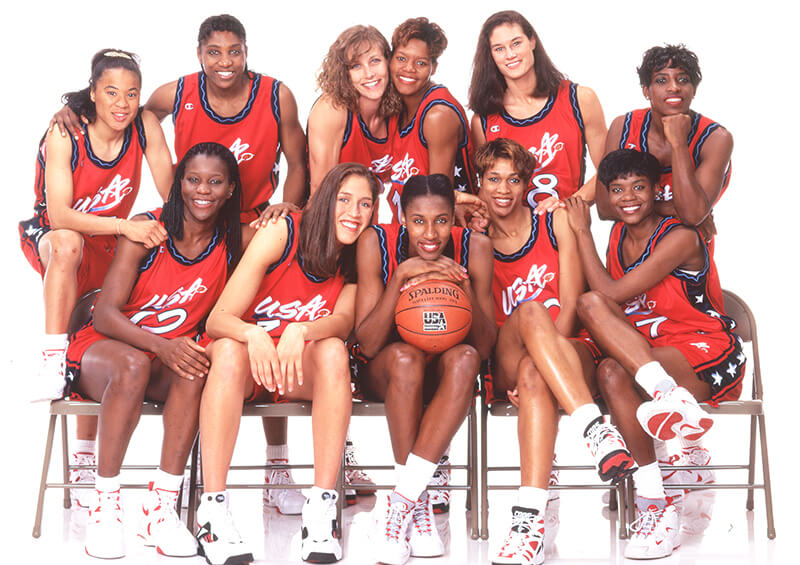Wednesday’s premiere of ESPN’s “30 for 30” documentary on the 1996 US Women’s basketball team gave the trailblazing women the flowers they finally deserved. The 3-part documentary titled “Dream On” gave viewers an inside look of the forming of the ’96 Dream Team and events that followed. Viewers that watched the documentary got a better understanding of how the team was able to achieve their historic 60-0 game run. Viewers also got an inside look at the players’ personal lives before and during their time on the team.
Coming in at an hour a piece for each part, this “30 for 30” installment is jam-packed with information and never before seen footage that may be a lot to take in on the first watch. However, for viewers that are looking to break down some of the information, here are some takeaways that we think you should know about.
Part 1:
Lisa Leslie and Dawn Staley both tried out for the 1992 Women’s Olympic basketball team but didn’t make the cut. In the documentary, Leslie spoke briefly about trying out to play for the team ahead of the ’92 Summer Games in Barcelona, however she did not make the team. Staley who would later play with Leslie spoke candidly in the documentary about being cut from the ’92 Women’s basketball team.
“I was told two things, one I was too short and was that I didn’t have enough international experience,” Staley said. “My reaction probably wasn’t tears it was a north Philly reaction.”
Both Leslie and Staley would later go on to make the ’94 Women’s US basketball team before making it through the tryouts for the ’96 Dream Team. Jennifer Azzi also tried out for the team and was also cut prior to the ’92 Summer Games, she would later make up one of the women on the team in 1996.
Part 2:
Before playing in the ’96 Summer Olympics, the team went on to play several women’s college basketball teams in the US. The reason for playing against these teams were to show how the Dream Team played at a professional level rather than a collegiate level. The Dream Team played against each of the colleges the players came from. Head coach Tara VanDerveer intentionally did not choose a player as a starter when they played their former school.
“I didn’t start anyone based on where they’re from,” VanDerveer said. “It was about basketball for me not the showmanship of it, so it was nothing personal.”
Though this may have been seen as snub to some, VanDerveer’s method of coaching appeared to work in the team’s favor.
Another key takeaway in part 2 is there had been several attempts at creating a national Women’s basketball league. In 1965 the All-American Redheads made their debut, a Harlem Globe trotter-like team that was short-lived. Then in the late ‘70s came the Women’s Basketball League which also fell through, then in the ‘90s came the Ladies Basketball Association. The LBA was also short-lived due to not grabbing the attention of mainstream media at the time.
Part 3:
Before the start of the ’96 Olympic Summer Games, the Dream Team added a 12th player to their team. Venus Lacey made the 12th woman to be a part of the team that helped team USA win gold in Women’s basketball. Lacey brought a strong defensive element that was lacking in the team, an element that proved effective in the eight games they played in ’96 Olympics.
As the team was progressing through the summer games, the bombing at Centennial Olympic Park in Atlanta almost caused the Olympics to be shut down completely. Almost jeopardizing their mission of winning gold and putting USA basketball back on top. Former President Bill Clinton issued an address stating that the games will continue, giving the Dream Team time to carry out their goal. The team finished the Olympics 60-0 beating Brazil 111-87.
[ALSO READ: 1996 US Women’s basketball team: What to know before watching ESPN’s documentary]
Present:
With the team going through year’s worth of training and playing, the NBA shortly launched the WNBA. Now entering its 25th year of exitance, these 12 women paved a way that was deemed impossible by many. After the ’96 Dream Team, Team USA has gone on to win 7 consecutive gold medals in Women’s basketball.
Since ’96 each of the women has chosen different paths, some of them becoming coaches themselves. However, one thing remains true and that is if it weren’t for these 12 women there’s no telling where women’s professional basketball would be.
Read More: Mets New Features and Food Offerings at Citi Field for 2024


































